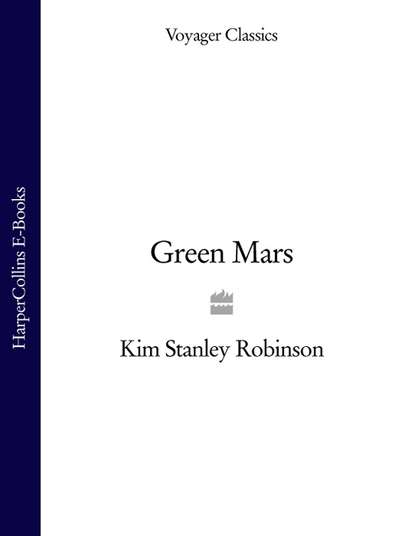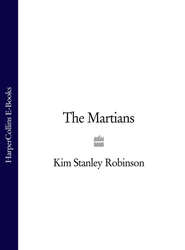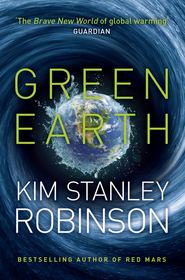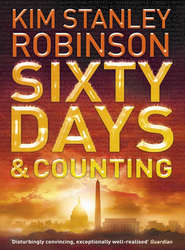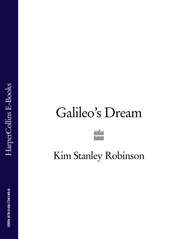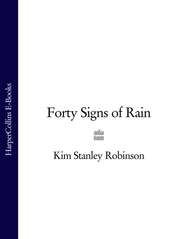По всем вопросам обращайтесь на: info@litportal.ru
(©) 2003-2024.
✖
Green Mars
Автор
Год написания книги
2018
Настройки чтения
Размер шрифта
Высота строк
Поля
He approached the mirror slowly, feeling the strange sensation of momentousness sweep through him again. He stared at the face in the mirror, stared and stared; it came to him that he was not the centre of the universe, nor its only consciousness, but a person like all the rest, seen from the outside by others, the way he saw others when he looked at them. And this strange Nirgal-in-the-mirror was an arresting black-haired brown-eyed boy, intense and compelling, a near twin to Jackie, with thick black eyebrows and a … a look. He didn’t want to know any of this. But he felt the power burning at his fingertips, and recalled how people looked at him, and understood that for Jackie he might represent the same sort of dangerous power that she did for him—which would explain her consorting with Dao, as an attempt to hold him off, to hold a balance, to assert her power. To show they were a matched pair—and a match. And all of a sudden the tension left his torso, and he shuddered, and then grinned, lopsidedly. They did indeed belong to each other. But he was still himself.
So when Coyote showed up and came by to ask Nirgal to join him on another trip, he agreed instantly, very thankful for the opportunity. The flash of anger on Jackie’s face when she heard the news was painful to see; but another part of him exulted at his otherness, at his ability to escape her, or at least to get some distance. Match or not, he needed it.
A few evenings later he and Coyote and Peter and Michel drove away from the huge mass of the polar cap, into the broken land, black under its blanket of stars.
Nirgal looked back at the luminous white cliff with a tumultuous mix of feelings; but chief among them was relief. Back there they would burrow ever deeper under the ice, it seemed, until they lived in a dome under the South Pole—while the red world spun through the cosmos, wild among the stars. Suddenly he understood that he would never again live under the dome, never return to it except for short visits; this was not a matter of choice, but simply the way it was going to happen. His fate, or destiny. He could feel it like a red rock in his hand. Henceforth he would be homeless—unless it be that the whole planet someday became his home, every crater and canyon known to him, every plant, every rock, every person—everything, in the green world and the white. But that (remembering the storm seen from the edge of Promethei Rupes) was a task to occupy many lives. He would have to start learning.
PART TWO The Ambassador (#ulink_37d18b8b-0625-5fca-93da-c7bb74414da4)
Asteroids with elliptical orbits that cross inside the orbit of Mars are called Amor asteroids. (If they cross inside the orbit of Earth they are called Trojans.) In 2088 the Amor asteroid known as 2034 B crossed the path of Mars some eighteen million kilometres behind the planet, and a clutch of robotic landing vehicles originating from Luna docked with it shortly thereafter. 2034 B was a rough ball about five kilometres in diameter, with a mass of about fifteen billion tons. As the rockets touched down, the asteroid became New Clarke.
Quickly the change became obvious. Some landers sank to the dusty surface of the asteroid and began drilling, excavating, stamping, sorting, conveying. A nuclear reactor power plant switched on, and fuel rods moved into position. Elsewhere ovens fired, and robot stokers prepared to shovel. On other landers payload bays opened, and robot mechanisms spidered out onto the surface and anchored themselves to the irregular planes of rock. Tunnellers bored in. Dust flew off into the space around the asteroid, and fell back down or escaped forever. Landers extended pipes and tubes into each other. The asteroid’s rock was carbonaceous chrondrite, with a good percentage of water-ice shot through it in veins and bubbles. Soon the linked collection of factories in the landers began to produce a variety of carbon-based materials, and some composites. Heavy water, one part in every six thousand of the water-ice in the asteroid, was separated out. Deuterium was made from the heavy water. Parts were made from the carbon composites, and other parts, brought along in another payload, were brought together with the new ones in factories. New robots appeared, made mostly of Clarke itself. And so the number of machines grew, as computers on the landers directed the creation of an entire industrial complex.
After that the process was quite simple, for many years. The principal factory on New Clarke made a cable of carbon nanotube filaments. The nanotubes were made of carbon atoms linked in chains so that the bonds holding them together were as strong as any that humans could manufacture. The filaments were only a few score metres long, but were bundled in clusters with their ends overlapping, and then the bundles were bundled, until the cable was nine metres in diameter. The factories could create the filaments and bundle them at speeds that allowed them to extrude the cable at a rate of about four hundred metres an hour, ten kilometres a day, for hour after hour, day after day, year after year.
While this thin strand of bundled carbon spun out into space, robots on another facet of the asteroid were constructing a mass driver, an engine that would use the deuterium from the indigenous water to fire crushed rock away from the asteroid at speeds of two hundred kilometres a second. Around the asteroid smaller engines and conventional rockets were also being constructed and stocked with fuels, waiting for the time when they would fire, and perform the work of attitude jets. Other factories constructed long-wheeled vehicles capable of running back and forth on the growing cable, and as the cable continued to appear out of the planet, small rocket jets and other machinery were attached to it.
The mass driver fired. The asteroid began to move into a new orbit.
Years passed. The asteroid’s new orbit intersected the orbit of Mars such that the asteroid came within ten thousand kilometres of Mars, and the collection of rockets on the asteroid fired in a way that allowed the gravity of Mars to capture it, in an orbit at first highly elliptical. The jets continued to fire off and on, regularising the orbit. The cable continued to extrude. More years passed.
A little over a decade after the landers had first touched down, the cable was approximately thirty thousand kilometres long. The asteroid’s mass was about eight billion tons, the cable’s mass was about seven billion. The asteroid was in an elliptical orbit with a periapsis of around fifty thousand kilometres. But now all the rockets and mass drivers on both New Clarke and the cable itself began to fire, some continuously but most in spurts. One of the most powerful computers ever made sat in one of the payload bays, co-ordinating the data from sensors and determining which rockets should fire when. The cable, at this time pointing away from Mars, began to swing around toward it, as in the pivoting of some delicate part of a timepiece. The asteroid’s orbit became smaller and more regular.
More rockets landed on New Clarke for the first time since that first touchdown, and robots in them began the construction of a spaceport. The tip of the cable began to descend toward Mars. Here the calculus employed by the computer soared off into an almost metaphysical complexity, and the gravitational dance of asteroid and cable with the planet became ever more precise, moving to a music that was in a permanent ritard, so that as the great cable grew closer to its proper position, its movements became slower and slower. If anyone had been able to see the full extent of this spectacle, it might have seemed like some spectacular physical demonstration of Zeno’s paradox, in which the racer gets closer to the finish line by halving distances … but no one ever saw the full spectacle, for no witnesses had the senses necessary. Proportionally the cable was far thinner than a human hair—if it had been reduced to a hair’s diameter, it would still have been hundreds of kilometres long—and so it was only visible for short portions of its entire length. Perhaps one might say that the computer guiding it in had the fullest sensation of it. For observers down on the surface of Mars, in the town of Sheffield, on the volcano Pavonis Mons (Peacock Mountain), the cable made its first appearance as a very small rocket descending with a very thin leader line attached to it; something like a bright lure and a thin fishing line, being trawled by some gods in the next universe up. From this ocean bottom perspective the cable itself followed its leader line down into the massive concrete bunker east of Sheffield with an aching slowness, until most humans simply stopped paying attention to the vertical black stroke in the upper atmosphere.
But the day came when the bottom of the cable, firing jets to hold its position in the gusty winds, dropped down into the hole in the roof of the concrete bunker, and settled into its collar. Now the cable below the areosynchronous point was being pulled down by Mars’s gravity; the part above the areosynchronous point was trying to follow New Clarke in centrifugal flight away from the planet; and the carbon filaments of the cable held the tension, and the whole apparatus rotated at the same speed as the planet, standing above Pavonis Mons in an oscillating vibration which allowed it to dodge Deimos, controlled still by the computer on New Clarke, and the long battery of rockets deployed on the carbon strand.
The elevator was back. Cars were lifted up one side of the cable from Pavonis, and other cars were let down from New Clarke, providing a counterweight so that the energy needed for both operations was greatly lessened. Spaceships made their approach to the New Clarke spaceport, and when they left they were given a slingshot departure. Mars’s gravity well was therefore substantially mitigated, and all its human intercourse with Earth and the rest of the solar system made less expensive. It was as if an umbilical cord had been retied.
He was in the middle of a perfectly ordinary life when they drafted him and sent him to Mars.
The summons came in the form of a fax which appeared out of his phone, in the apartment Art Randolph had rented just the month before, after he and his wife had decided on a trial separation. The fax was brief: Dear Arthur Randolph: William Fort invites you to attend a private seminar. A plane will leave San Francisco airport at9a.m., February 22nd 2101.
Art stared at the paper in amazement. William Fort was the founder of Praxis, the transnational that had acquired Art’s company some years before. Fort was very old, and now his position in the transnat was said to be some kind of semi-retired emeritus thing. But he still held private seminars, which were notorious although there was very little hard information about them. It was said that he invited people from all subsidiaries of the transnat; that they gathered in San Francisco, and were flown away by private jet to somewhere secret. No one knew what went on there. People who attended were usually transferred afterward, and if not, they kept their mouths shut in a way that gave one pause. So it was a mystery.
Art was surprised to be invited, apprehensive but basically pleased. Before its acquisition he had been the co-founder and technical director of a small company called Dumpmines, which was in the business of digging up and processing old landfills, recovering the valuable materials that had been thrown away in a more wasteful age. It had been a surprise when Praxis had acquired them, a very pleasant surprise, as everyone in Dumpmines went from employment in a small firm, to apprentice membership in one of the richest organisations in the world—paid in its shares, voting on its policy, free to use all its resources. It was like being knighted.
Art certainly had been pleased, and so had his wife, although she had been elegiac as well. She herself had been hired by Mitsubishi’s synthesis management, and the big transnationals, she said, were like separate worlds. With the two of them working for different ones they were inevitably going to drift apart, even more than they already had. Neither of them needed the other any more to obtain longevity treatments, which transnats provided much more reliably than the government. And so they were like people on different ships, she said, sailing out of San Francisco Bay in different directions. Like ships, in fact, passing in the night.
It had seemed to Art that they might have been able to commute between ships, if his wife had not been so interested in one of the other passengers on hers, a vice-chairman of Mitsubishi in charge of East Pacific development. But Art had been quickly caught up in Praxis’s arbitration programme, travelling frequently to take classes or arbitrate in disputes between various small Praxis subsidiaries involved in resource recovery, and when he was in San Francisco, Sharon was very seldom at home. Their ships were moving out of hailing distance, she had said, and he had become too demoralised to contest the point, and had moved out soon afterward, on her suggestion. Kicked out, one could have said.
Now he rubbed a swarthy unshaven jaw, re-reading the fax for the fourth time. He was a big man, powerfully built but with a tendency to slouch— “uncouth” his wife had called him, although his secretary at Dumpmines used the term “bearlike”, which he preferred. Indeed he had the somewhat clumsy and shambling appearance of a bear, also its surprising quickness and power. He had been a fullback at the University of Washington, a fullback slow of foot but decisive in direction, and very difficult to bring down. Bear Man, they had called him. Tackle him at your peril.
He had studied engineering, and afterward worked in the oilfields of Iran and Georgia, devising a number of innovations for extracting oil from extremely marginal shale. He had got a master’s degree from Tehran University while doing this work, and then had moved to California and joined a friend who was forming a company that made deep-sea diving equipment used in offshore oil drilling, an enterprise which was moving out into ever-deeper water as more accessible supplies were exhausted. Once again Art had invented a number of improvements in both diving gear and underwater drills, but a couple of years spent in compression chambers and on the continental shelf had been enough for him, and he had sold his shares to his partner and moved on again. In quick succession he had started a cold environments habitat construction company, worked for a solar panel firm, and built rocket gantries. Each job had been fine, but as time passed he had found that what really interested him were not the technical problems but the human ones. He became more and more involved with project management, and then got into arbitration; he liked jumping into arguments and solving them to everyone’s mutual satisfaction. It was engineering of a different kind, more engrossing and fulfilling than the mechanical stuff, and more difficult. Several of the companies he worked for in those years were part of transnationals, and he got embroiled in interface arbitration not only between his companies and others in the transnats, but also in more distant disputes requiring some kind of third party arbitration. Social engineering, he called it, and found it fascinating.
So when starting Dumpmines he had taken the technical directorship, and had done some good work on their SuperRathjes, the giant robot vehicles that did the extraction and sorting at the landfills; but more than ever before he involved himself in labour disputes and the like. This trend in his career had accelerated after the acquisition by Praxis. And on the days when work like that went well, he always went home knowing that he should have been a judge, or a diplomat. Yes—at heart he was a diplomat.
Which made it embarrassing that he had not been able to negotiate a successful outcome to his own marriage. And no doubt the break-up was well-known to Fort, or whoever had invited him to this seminar. It was even possible that they had bugged his old apartment, and heard the unhappy mess of his and Susan’s final months together, which wouldn’t have been flattering to either of them. He cringed at the thought, still rubbing his rough jaw, and drifted toward the bathroom and turned on the portable hot water heater. The face in the mirror looked mildly stunned. Unshaven, fifty, separated, mis-employed for most of his life, just beginning at his true calling—he was not the kind of person that he imagined got faxes from William Fort.
His wife or ex-wife-to-be called, and she was likewise incredulous. “It must be a mistake,” she said when Art told her about it.
She had called about one of her camera lenses, now missing; she suspected that Art had taken it when he moved out. “I’ll look for it,” Art said. He went over to the closet to look in his two suitcases, still unpacked. He knew the lens was not in them, but he rooted loudly through them both anyway. Sharon would know if he tried to fake it. While he searched she continued to talk over the phone, her voice echoing tinnily through the empty apartment. “It just shows how weird that Fort is. You’ll go to some Shangri-La and he’ll be using kleenex boxes for shoes and talking Japanese, and you’ll be sorting his trash and learning to levitate and I’ll never see you again. Did you find it?”
“No. It’s not here.” When they had separated they had divided their joint possessions: Sharon had taken their apartment, the entertainment centre, the desktop array, the lectern, the cameras, the plants, the bed, and all the rest of the furniture; Art had taken the teflon frying pan. Not one of his best arbitrations. But it meant he now had very few places to search for the lens.
Sharon could make a single sigh into a comprehensive accusation. “They’ll teach you Japanese, and we’ll never see you again. What could William Fort want with you?”
“Marriage counselling?” Art said.
Many of the rumours about Fort’s seminars turned out to be true, which Art found amazing. At San Francisco International he got on a big powerful private jet with six other men and women, and after takeoff the jet’s windows, apparently double polarised, went black, and the door to the cockpit was closed. Two of Art’s fellow passengers played at orienteering, and after the jet made several gentle banks left and right, they agreed that they were headed some direction between southwest and north. The seven of them shared information: they were all technical managers or arbitrators from the vast network of Praxis companies. They had flown in to San Francisco from all over the world. Some seemed excited to be invited to meet the transnational’s reclusive founder; others were apprehensive.
Their flight lasted six hours, and the orienteers spent the descent plotting the outermost limit of their location, a circle that encompassed Juneau, Hawaii, Mexico City and Detroit, although it could have been larger, as Art pointed out, if they were in one of the new air-to-space jets; perhaps half the Earth or more. When the jet landed and stopped, they were led through a miniature jetway into a big van with blackened windows, and a windowless barrier between them and the driver’s seat. Their doors were locked from the outside.
They were driven for half an hour. Then the van stopped and they were let out by their driver, an elderly man wearing shorts and a T-shirt advertising Bali.
They blinked in the sunlight. They were not in Bali. They were in a small asphalt parking lot surrounded by eucalyptus trees, at the bottom of a narrow coastal valley. An ocean or very big lake lay to the west about a mile, just a small wedge of it in sight. A creek drained the valley, and ran into a lagoon behind a beach. The valley’s side walls were covered with dry grass on the south side, cactus on the north; the ridges above were dry brown rock. “Baja?” one of the orienteers guessed. “Ecuador? Australia?”
“San Luis Obispo?” Art said.
Their driver led them on foot down a narrow road to a small compound, composed of seven two-storey wooden buildings, nestled among seacoast pines at the bottom of the valley. Two buildings by the creek were residences, and after they dropped their bags in assigned rooms in these buildings, the driver led them to a dining room in another building, where half a dozen kitchen workers, all quite elderly, fed them a simple meal of salad and stew. After that they were taken back to the residences, and left on their own.
They gathered in a central chamber around a woodburning stove. It was warm outside, and there was no fire in the stove.
“Fort is a hundred and twelve,” the orienteer named Sam said. “And the treatments haven’t worked on his brain.”
“They never do,” said Max, the other orienteer.
They discussed Fort for a while. All of them had heard things, for William Fort was one of the great success stories in the history of medicine, their century’s Pasteur: the man who beat cancer, as the tabloids inaccurately put it. The man who beat the common cold. He had founded Praxis at the age of twenty-four, to market several breakthrough innovations in antivirals, and he had been a multi-billionaire by the time he was twenty-seven. After that he had occupied his time by expanding Praxis into one of the world’s biggest transnationals. Eighty continuous years of metastasising, as Sam put it. While mutating personally into a kind of ultra-Howard Hughes, or so it was said, growing more and more powerful, until like a black hole he had disappeared completely inside the event horizon of his own power. “I just hope it doesn’t get too weird,” Max said.
The other attendants—Sally, Amy, Elizabeth and George—were more optimistic. But all of them were apprehensive at their peculiar welcome, or lack of one, and when no one came to visit them through the rest of that evening, they retired to their rooms looking concerned.
Art slept well as always, and at dawn he woke to the low hoot of an owl. The creek burbled below his window. It was a grey dawn, the air filled with the fog that nourished the sea pines. A tocking sound came from somewhere in the compound.
He dressed and went out. Everything was soaking wet. Down on narrow flat terraces below the buildings were rows of lettuce, and rows of apple trees so pruned and tied to frameworks that they were no more than fan-shaped bushes.
Colours were seeping into things when Art came to the bottom of the little farm, over the lagoon. There a lawn lay spread like a carpet under a big old oak tree. Art walked over to the tree, feeling drawn to it. He touched its rough, fissured bark. Then he heard voices; coming up a path by the lagoon were a line of people, wearing black wetsuits and carrying surfboards, or long folded birdsuits. As they passed he recognised the faces of the previous night’s kitchen crew, and also their driver. The driver waved and continued up the path. Art walked down it to the lagoon. The low sound of waves mumbled through the salty air, and birds swam in the reeds.
After a while Art went back up the trail, and in the compound’s dining room he found the elderly workers back in the kitchen, flipping pancakes. After Art and the rest of the guests had eaten, yesterday’s driver led them upstairs to a large meeting room. They sat on couches arranged in a square. Big picture windows in all four walls let in a lot of the morning’s grey light. The driver sat on a chair between two couches. “I’m William Fort,” he said. “I’m glad you’re all here.”
He was, on closer inspection, a strange-looking old man; his face was lined as if by a hundred years of anxiety, but the expression it currently displayed was serene and detached. A chimp, Art thought, with a past in lab experimentation, now studying Zen. Or simply a very old surfer or hang-glider (which had he been carrying?), weathered, bald, round-faced, snub-nosed. Now taking them in one by one. Sam and Max, who had ignored him as driver and cook, were looking uncomfortable, but he didn’t seem to notice. “One index,” he said, “for measuring how full the world is of humans and their activities, is the percent appropriation of the net product of land-based photosynthesis.”
Sam and Max nodded as if this were the usual way to start a meeting.
“Can I take notes?” Art asked.
“Please,” Fort said. He gestured at the coffee table in the middle of the square of couches, which was covered with papers and lecterns. “I want to play some games later, so there’s lecterns and workpads, whatever you like.”
Most of them had brought their own lecterns, and there was a short silent scramble as they got them out and running. While they were at it Fort stood up and began walking in a circle behind their couches, making a revolution every few sentences.





